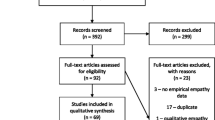Abstract
Background
Little is known about the influence of patient-perceived healthcare provider empathy on patient satisfaction in the setting of a hospital pain clinic consultation. The objective of this research was to examine the relationship between patient-rated physician empathy and patient satisfaction after a single new pain clinic consultation.
Methods
After institutional ethics committee approval, a sample of 140 adult patients completed a two-page questionnaire, directly after a pain clinic consultation. This included a brief sociodemographic questionnaire, the Consultation and Relational Empathy (CARE) measure and an overall satisfaction rating.
Results
The sample, N = 140 patients, was balanced for gender and 80% of participants ranged in age from 30 to 70. Of these patients, 80.7% had been living with chronic pain between 1 and 5 years. The data were deemed to be non-parametric and a Spearman’s ranked order correlation analysis yielded a strong positive correlation between patient-rated physician empathy and patient consultation satisfaction.
Conclusion
Patient-rated physician empathy was strongly correlated with patient satisfaction in a pain clinic consultation. Patient satisfaction plays a significant role in adherence to treatment and contributes to a positive working patient-physician therapeutic relationship. This research supports the growing body of research citing the importance of investing in, promoting and developing educational programs for physicians and medical trainees to enhance empathic communication skills within the clinical setting.



Similar content being viewed by others
References
Han JL, Pappas TN (2018) A review of empathy, its importance, and its teaching in surgical training. J Surg Educ 75:88–94
Menendez ME, Chen NC, Mudgal CS, Jupiter JB, Ring D (2015) Physician empathy as driver of hand surgery patient satisfaction. J Hand Surg 40(9):1860–1865
Hopayian K, Notley C (2014) A systematic review of low back pain and sciatica patients’ expectations and experiences of health care. Spine J 14:1769–1780
Mercer SW, Reynolds WJ (2002) Empathy and quality of care. Br J Gen Pract 52(suppl):S9–S12
Eagle M, Wolitsky DL (1997) Empathy: a psychoanalytic perspective. In: Bohart AC, Greenberg LS (eds) Empathy reconsidered: new directions in psycho-therapy. APA, Washington, DC, pp 217–244
Pedersen R (2009) Empirical research on empathy in medicine —a critical review. Patient Educ Couns 76(3):307–322
Neuwirth ZE (1997) Physician empathy—should we care? Lancet 350:606
Singh M (2016) Communication as a bridge to build a sound Doctor-Patient/Parent relationship. Indian J Pediatr 83:33
Beck RS, Daughtridge R, Sloane PD (2001) Physician-patient communication in the primary care office: a systematic review. J Am Board Fam Pract 15(1):25–38
Zachariae R, Pedersen CG, Jensen AB, Ehrnrooth E, Rossen PB, von der Maase H (2003) Association of perceived physician communication style with patient satisfaction, distress, cancer-related self-efficacy, and perceived control over the disease. Br J Cancer 88(5):658–665
Hojat M, Louis DZ, Markham FW, Wender R, Rabinowitz C, Gonnella JS (2011) Physicians’ empathy and clinical outcomes for diabetic patients. Acad Med 86(3):359–364
Thirioux B, Birault F, Jaafari N (2016) Empathy is a protective factor of burnout in physicians: new neuro-phenomenological hypotheses regarding empathy and sympathy in care relationship. Front Psychol 7:763
Ambady N, Laplante D, Nguyen T et al (2002) Surgeons’ tone of voice: a clue to malpractice history. Surgery 132(1):5–9
Levinson W, Roter DL, Mullooly JP, Dull VT, Frankel RM (1997) Physician- patient communication: the relationship with malpractice claims among primary care physicians and surgeons. JAMA 277(7):553–559
Banja JD (2006) Empathy in the physicians pain practice: benefits, barriers and recommendations. Pain Med 7(3):265–275
Havens L (1986) Making contact: uses of language in psychotherapy. Harvard University Press, Cambridge
Rafferty MN, Ryan P, Normand C et al (2012) The economic cost of chronic non-cancer pain in Ireland: results from the PRIME study, part 2. J Pain 13(2):139–145
Kravitz R (1998) Patient satisfaction with health care: critical outcome or trivial pursuit? J Gen Intern Med 13(4):280–282
Kupfer JM, Bond EU (2012) Patient satisfaction and patient-centered care: necessary but not equal. JAMA 308(2):139–140
Szablowski KM (2014) Hospital value-based purchasing (VBP) program: measurement of quality and enforcement of quality improvement. Conn Med 78(1):49–51
Welty E, Yeager VA, Ouimet C, Menachemi N (2012) Patient satisfaction among Spanish-speaking patients in a public health setting. J Healthc Qual 34(5):31–38
The World Health Report (2008) Primary health care now more than ever. World Health Organization, Geneva
Arora S, Ashrafian H, Davis R, Athanasiou T, Darzi A, Sevdalis N (2010) Emotional intelligence in medicine: a systematic review through the context of the ACGME competencies. Med Educ 44(8):749–764
Zolnierek KB, Dimatteo MR (2009) Physician communication and patient adherence to treatment: a meta-analysis. Med Care 47:826–834
Ong LM, de Haes JC, Hoos AM et al (1995) Doctor-patient communication: a review of the literature. Soc Sci Med 40:903–918
Stewart M, Brown JB, Boon H, Galajda J, Meredith L, Sangster M (1999) Evidence on patient-doctor communication. Cancer Prev Control 3:25–30
Jha AK, Orav EJ, Zheng J, Epstein AM (2008) Patients’ perception of hospital care in the United States. N Engl J Med 359(18):1921–1931
Bicker AP, Fitzpatrick B, Murphy D et al (2017) Assessing the consultation and relational empathy (CARE) measure in sexual heath nurses’ consultations. BMC Nurs 16(71)
Onwuegbuzie AJ, Daniel LG (2002) A framework for reporting and interpreting internal consistency reliability estimates. Meas Eval Couns Dev 35(2):89–100
Author information
Authors and Affiliations
Corresponding author
Ethics declarations
Conflict of interest
The authors declare that they have no conflict of interest.
Ethical approval
All procedures performed were in accordance with the ethical standards of the institutional and/or national research committee and with the 1964 Helsinki declaration and its later amendments or comparable ethical standards.
Informed consent
Informed consent was obtained from all individual participants included in the study.
Additional information
Publisher’s note
Springer Nature remains neutral with regard to jurisdictional claims in published maps and institutional affiliations.
Rights and permissions
About this article
Cite this article
Walsh, S., O’Neill, A., Hannigan, A. et al. Patient-rated physician empathy and patient satisfaction during pain clinic consultations. Ir J Med Sci 188, 1379–1384 (2019). https://doi.org/10.1007/s11845-019-01999-5
Received:
Accepted:
Published:
Issue Date:
DOI: https://doi.org/10.1007/s11845-019-01999-5



